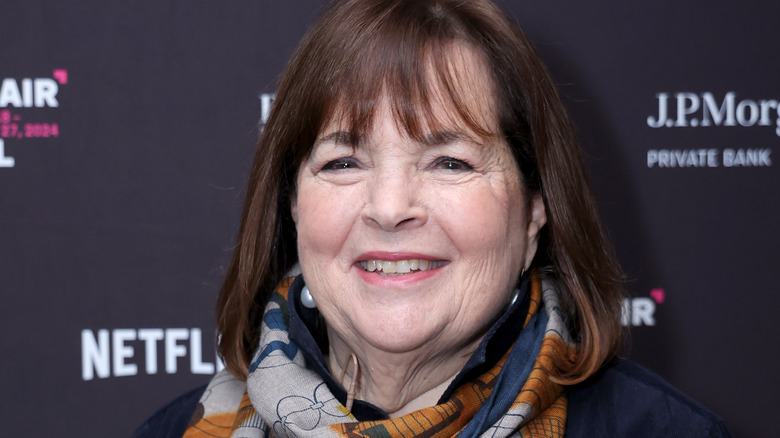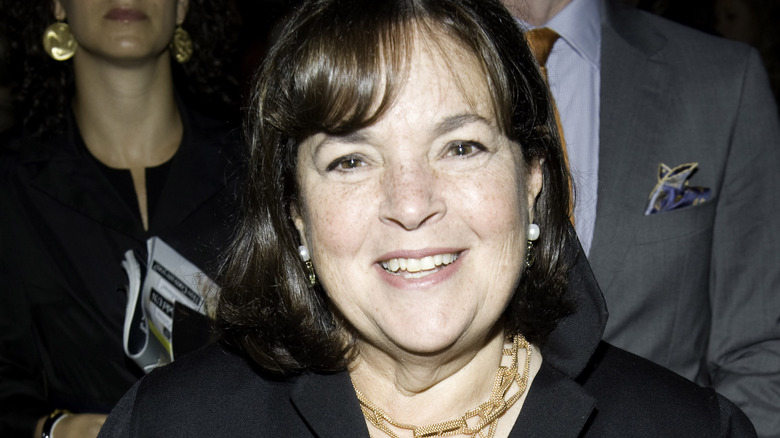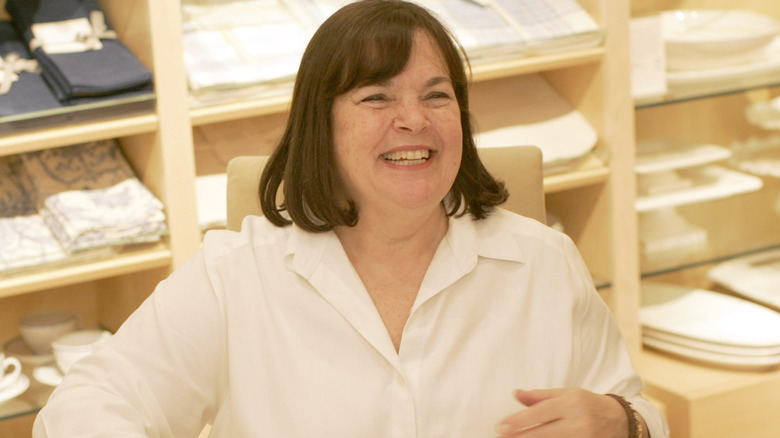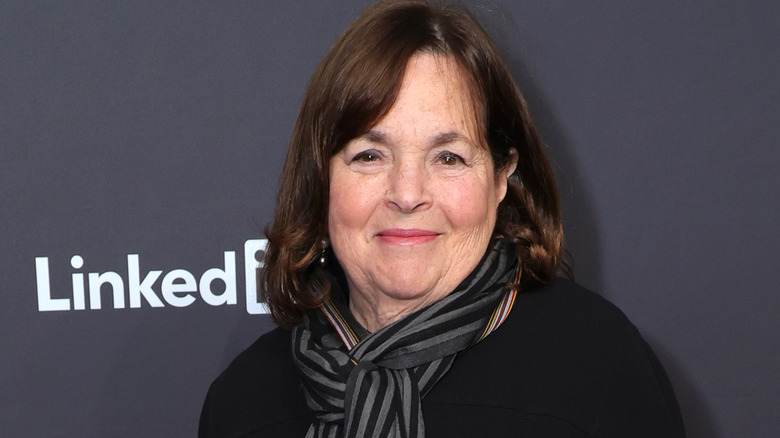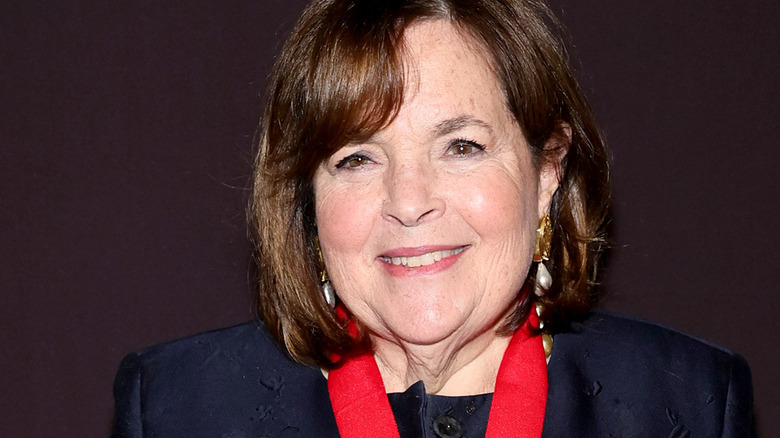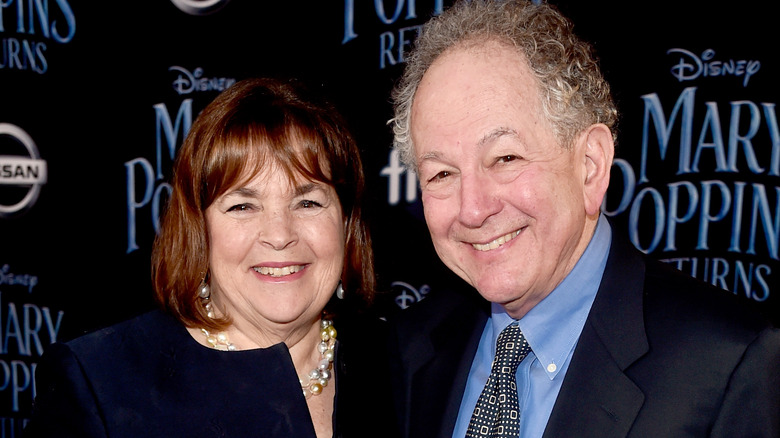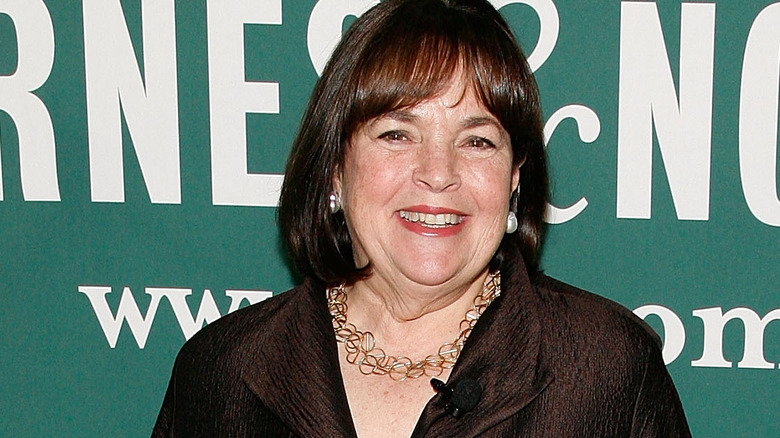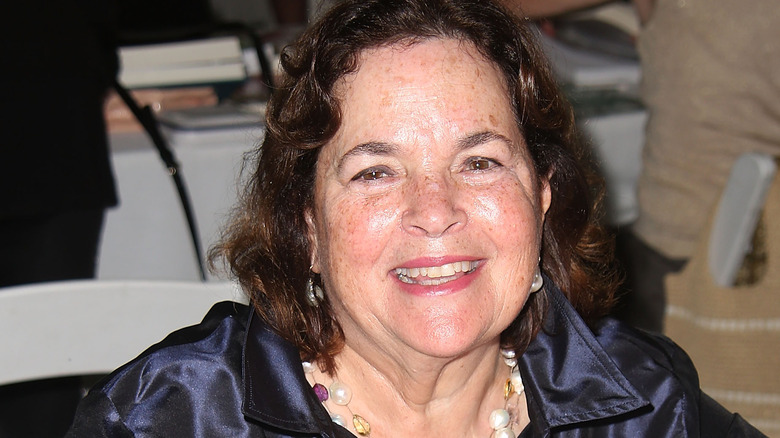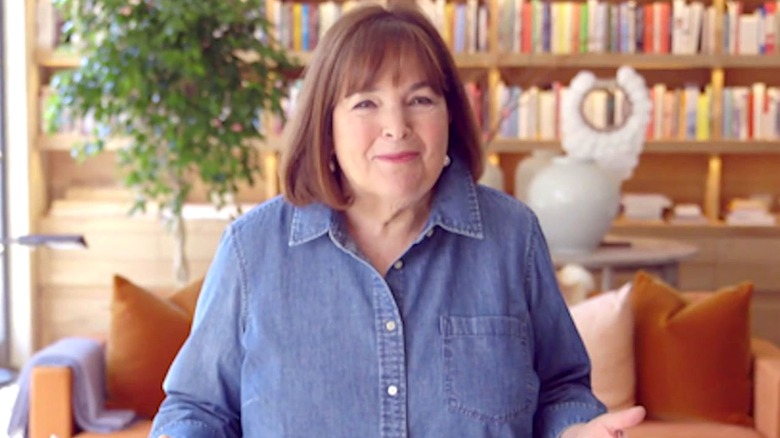Ina Garten's Real-Life Struggles Are Truly Heartbreaking
Based on her various Food Network shows, Ina Garten really seems like she's perfected life. The star and mind behind the long-running "Barefoot Contessa" franchise left behind a White House job to pursue culinary creativity in the form of running a gourmet grocery store in one of America's highest-end locales. Then she decided to share her secrets of cooking, entertaining, and just plain living well with the masses. Always calm and collected, Garten makes cooking on camera look glamorous, residing in a world that appears both enviable and elegant.
But while "Barefoot Contessa" is heavily couched in reality and depicts a lot of real elements from Garten's life, it's ultimately still a TV show. Offscreen, the seemingly superhuman Garten is just a person, and she's faced more than her fair share of heartache, setbacks, and tragedy. Garten is known for rhetorically asking viewers, "How easy is that?" The answer, as it pertains to the cook and TV star, is "not always." Here's a look at the rarely explored dark and sad side of Ina Garten.
Ina Garten was raised in an abusive household
Growing up in New York and Connecticut in the 1950s and 1960s, Ina Garten remembers her mother, Florence Rosenberg, making sure that her children were taken care of and that their minds were enriched. "But none of it was done with joy or warmth," Garten told Today. In retrospect, she believes that her mother lacked the emotional capacity to foster relationships, and that she maybe didn't, or couldn't, love her kids. "She didn't understand me, actually," Garten said. "I'm sure about that."
While the damage endured from her mother came from a lack of emotional and physical contact, the treatment she received from her father, Charles Rosenberg, was unequivocally and outwardly abusive. "My father had very strict views of what we should do," Garten recalled, which included excelling in school and at tennis. If she deviated from that ideal, she was "met with extreme anger." That included physical abuse. "I actually stayed in my room to stay safe. I think I was terrified that he was going to kill me." Garten recalls being pulled around by her hair as punishment for minor indiscretions. "I think he loved me, but he wanted me to be who he wanted me to be, without any consciousness of who I am," Garten told The New Yorker.
Ina Garten and her brother weren't allowed to interact much
Ina Garten, formerly Ina Rosenberg, wasn't raised alone in an emotionally cold household with her parents. The chef has a brother, Ken Rosenberg. However, she rarely saw him when they were kids — even though they grew up together at the same time and under the same roof.
The primary objective for the Rosenberg children, as dictated by their parents, was achieving success in school. Both Ina and Ken were tasked with devoting most of their time to studying, acquiring new knowledge, collecting achievements, and improving their mental acuity. That meant the children were largely kept apart, left to do their work on their own. "We were raised as if we were only children, with little interaction between us," Garten wrote in her memoir, "Be Ready When Luck Happens." "Neither of us remembers ever setting foot in the other's bedroom," she said. They only had one shared (but still very regulated) pastime. "We played chess (considered educational) at breakfast," Garten recalled, adding that her brother always won.
Her food was strictly restricted in childhood
Through her many best-selling cookbooks and "Barefoot Contessa" shows on Food Network, Ina Garten has introduced millions to the wonders of good food. That's a stark and happy contrast to Garten's relationship with food as a child, when she was under the care of her mother. Florence Rosenberg had studied to be a dietitian, and that education manifested in a heavily restricted diet for her children. Garten told The New Yorker that her mother was "obsessed with what she ate" and that food was largely about nutrition, not pleasure. "My mother didn't understand pleasure."
Most carbohydrates and all desserts were forbidden in Garten's household when she was growing up. After Garten's father suffered a heart attack just after the age of 40, all sources of dietary cholesterol were banned, too. That included butter and cream for coffee, with skim milk used instead. "You might as well put water in your coffee," Garten said. In general, the choices were slim, bland, and stark. Garten recalled eating little more than broiled chicken, peas from a can (which ought to be avoided), and the occasional apple. "That's why I make chocolate cake," she quipped to Parade.
Ina Garten's childhood impacted her own views on parenthood
The former Ina Rosenberg wed Jeffrey Garten in December 1968 and the couple has always been a family of two. As if it's anyone else's business, Ina Garten has long had to answer questions from fans and reporters as to why she and her husband never had any children. It's a conscious decision the couple arrived at, following some deliberation. "When I got married, I just thought I would be the wife and we would have children and we would have a traditional relationship," Garten told Today in 2024. "And then one day, maybe when I was around 25, I thought, I just don't want to have children. I just don't want to do that." Jeffrey Garten concurred with his wife's decision. "He wants me to be happy," she explained.
Garten figured out what caused her to reject parenthood: her own rotten childhood. "I grew up in a family that wasn't a happy family, so I couldn't understand why people had kids," she told People. "Nobody had any fun in my family. Now I understand it, but at the time, when I was 25 and 30, I just didn't. It was nothing I really wanted to do."
Ina and Jeffrey Garten nearly split up
When Ina Garten was 15 years old, she accompanied her parents on a visit to her brother at Dartmouth College. Student Jeffrey Garten noticed Ina when she walked by. Miraculously, his roommate knew her — he belonged to the same tennis club as her brother, Ken, in Connecticut — and a date was arranged. About five years later, in 1968, Jeffrey and Ina Garten married, and they're still together nearly 60 years later.
But about a decade after the wedding, Garten contemplated ending her marriage. While both spouses worked intensive and important jobs outside of the home, it was Ina Garen who was expected to still keep up with the tasks traditionally assigned to women, such as cooking and laundry. A few months after she started running the Barefoot Contessa store in 1978, Garten was so frustrated by the homemaking expectations placed upon her that she tried to walk away from it all. She asked Jeffrey to separate, but instead, they examined their relationship and rethought their roles. Joint appearances in public and on Food Network suggest that the pair's relationship is still going strong today.
Her first big attempts at food flopped
Ina Garten's nickname, the Barefoot Contessa, is bestowed upon most of her professional projects, from cookbooks to Food Network programs. It all goes back to 1978, when Garten left her job at the White House Office of Management and Budget and purchased a small gourmet and specialty foods store in East Hampton. It was already called the Barefoot Contessa, itself named for a 1954 movie starring Ava Gardner. "I remember telling Jeffrey this may be the stupidest thing I've ever done, but it was also so exhilarating," Garten recalled in a post on her Instagram in 2024.
Nearly two decades later, Garten realized that it was time to move on to something more difficult, and she sold the operation to its manager and chef. "What I didn't like about running Barefoot Contessa was overshadowing what I used to love," Garten wrote in "Be Ready When Luck Happens." "I certainly wasn't bringing any creativity to my work," she added, lamenting having to spend time on shoplifting issues.
Eventually, Garten would become very comfortable on television, but her first attempt went poorly. In 2000, Martha Stewart's company prepared a show for the Food Network called "Someone's in the Kitchen with Ina." Shot on location at Garten's home, she got anxious with the crew traipsing around and feared she'd pale in comparison to Stewart. A director chastised her for talking with her mouth full, and Garten decided (albeit temporarily) that she didn't want to appear on TV ever again. Food Network ultimately axed the project and never aired the footage.
Ina Garten's parents died in rapid succession
Through childhood and well into adulthood, Ina Garten's relationships with both of her parents were emotionally fraught and tense. However, Garten began to make peace with Charles Rosenberg in 2001 at a party her parents held to celebrate the publication of their daughter's second cookbook, "Barefoot Contessa Parties!" "My father and I were sitting in a corner. He said, 'I don't know what I was thinking,'" Garten recalled to The New Yorker, describing her father's blanket apology for all past acts. "I realized he was torturing himself — he tortured us, but he was torturing himself that he'd done it."
Rosenberg died in 2004, and scarcely two years later, Garten's mother, Florence Rosenberg, died, too. They didn't get to undertake the same healing that Garten and her father did. "He, in his own way, apologized and my mom never acknowledged it," Garten lamented to People.
Ina Garten's friendship with Martha Stewart fell apart
Martha Stewart built an empire based on tasteful and well-done cooking, entertaining, decorating, and other aspects of the home, and she was so influential in the 1990s that she could pluck favorite artisans or curators out of obscurity and make them stars in their own right. In 1990, Stewart bought a home in East Hampton, New York, not far from where Garten lived. Stewart adored Garten's Barefoot Contessa store, and this spawned both a close friendship and business arrangement, with a feature on the shopkeeper running in the very first issue of "Martha Stewart Living." The pair were close enough that Stewart even shared her personal advice with Garten before her first book tour.
Some years later, Stewart shifted her base of operations to a house in Bedford, New York, causing the two to gradually grow apart and talk less. That's according to Garten, at least. Stewart maintains that her former friend abandoned her during a low point. "When I was sent off to Alderson Prison, she stopped talking to me," Stewart told The New Yorker for its profile on Garten. "I found that extremely distressing and extremely unfriendly."
She botched a Make-A-Wish request
Ina Garten's "Barefoot Contessa" began airing on Food Network in 2002, and one of the many fans she acquired during her first decade on the air was a child named Enzo Pereda. Following a diagnosis of acute lymphoblastic leukemia at the age of 3, Pereda spent a lot of the next three years in bed, where he watched "Barefoot Contessa" for comfort. When the Make-A-Wish Foundation approached Pereda about fulfilling a lofty request, he knew exactly what to ask for: to spend some time and make a meal with Garten.
In a controversial move that the Food Network star probably wishes we'd forget, Garten declined the visit, as she was busy with a book tour at the time. Pereda and Make-A-Wish asked again in 2011. Once more, Pereda's request was denied. The story went viral after Pereda's mother discussed their non-relationship with Garten on her blog. Not long after, Garten invited Pereda to come by the set of "Barefoot Contessa," with her team offering a quick explanation for her previous refusals. "Ina receives approximately 100 requests a month to support charitable causes," a representative for Garten said in a statement (via ABC News). "She contributes both personally and financially on a regular basis to numerous causes, including to Make-A-Wish Foundation. Sadly, it's of course not possible to do them all." On behalf of his son, Adrian Pereda said no to Garten's offer. "I don't want my son to go through any other stress," he said. "We just want to go on with our life."
